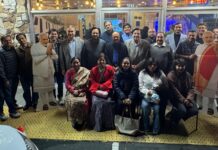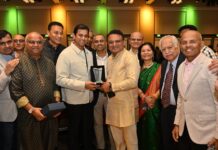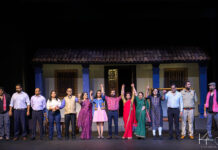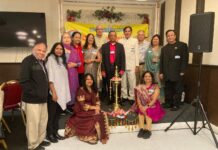 Listening to Ravi Shankar one day as a teenager in Paris eventually changed my life forever. Soon after, also under the influence of Mahatma Gandhi’s life and the teachings of Sri Aurobindo, I was embarking on an Indian journey to prepare my PhD in philosophy at the Banaras Hindu University.
Listening to Ravi Shankar one day as a teenager in Paris eventually changed my life forever. Soon after, also under the influence of Mahatma Gandhi’s life and the teachings of Sri Aurobindo, I was embarking on an Indian journey to prepare my PhD in philosophy at the Banaras Hindu University.
During my 12 years living and researching from the late 70s in the sacred city, I had the unique privilege of listening to the maestro in his birth place, where concerts typically started at sunset and continued till the sun (ravi) began rising from the Ganga to the raga Sindhu Bhairavi. Sessions long and leisurely enough for one to plunge into the intricacies and nuances of Indian classical music, exploring and savoring each note (svara). He was accompanied then on the tabla by Alla Rakha.
More recently, living in Chicago, I’ve twice heard Ravi Shankar perform live at the Symphony Center in “duets” (jugalbandi) with his brilliant daughter Anoushka. The torch of tradition and continued experimentation had been assured, but the audience still remained captivated by the legendary father. Although these concerts were necessarily briefer, his music spread the same energy, strength, depth, the same beauty, and offered us the same inspiration and aspiration.
This cultural “ambassador” from India has worked and played hard to initiate a genuine and growing, not only musical, dialogue between East and West that underlines both the differences and the similarities, creating bridges while ensuring the unique identity of each. The ongoing encounter was epitomized by his collaboration with violinist Yehudi Menuhin. He worked later with Philip Glass, Zubin Mehta, flautist Jean-Pierre Rampal, cellist Mstislav Rostropovich, John Coltrane, and others.
Ravi Shankar was the first Indian to teach Western audiences how to appreciate his music and its underlying traditions and values, how to understand and what to expect from a raga and its unending improvisations. He also reached out beyond the West to collaborate with artistes from the Far East, including Japanese musicians such as Hozan Yamamoto, a shakuhachi player, and Susumu Miyashita, a koto player. He composed music not only for his solitary sitar but also for orchestra and to accompany Indian movies such as Satyajit Ray’s Apu Trilogy and later for Attenborough’s Gandhi.
The pioneer never stopped working and playing, innovating till the end. His last DVD, titled Tenth Decade in Concert: Live in Escondido, from East Meets West Music, released in November 2012 by Alan Kozlowski, was recorded on October 9, 2011 at the California Center for the Arts, Escondido. Shankar introduces here, for the first time, Goonga Sitar, based on muffling the sonority of the strings with a piece of cloth. His last concert with daughter Anoushka, with whom he performed frequently, was on November 4, 2012, at a venue close to home in Long Beach, California.
The official recording label of the Ravi Shankar Foundation, East meets West Music, well illustrates Pandit Ravi Shankar’s assured status as pioneer in this domain. A historical figure, he was born into colonial India, lived through the Independence struggle, and survived well into our 21st century.
Ripe in years at passing, the Hindu musician from the timeless holy city was modern well before his times. He understood before most contemporaries the meaning of globalization, multiculturalism, and was adept at adapting to change while preserving his core identity. This rootedness is perhaps best captured by the moving scene in “Between Two Worlds” (BBC documentary on DVD) of his visit to his Guru, from whom he had received so many admonishments, to sing now in tearful unison.
Within his own country and with implications for nation-building, this Varanasi-born Bengali disciple of Ustad Alauddin Khan, popularized Carnatic ragas – such as Hamsadhwani, Kirwani, and Malaya Marutam – among North Indian musicians and connoisseurs. He played in unison (jugalbandi) with Muslim instrumentalists, starting with his Guru’s son and former brother-in-law, Ali Akbar Khan. Instead of pursuing inter-religious and intercultural dialogue through the acrimonious exchange of speeches, he enacted the same to the shared delight of hybrid audiences on the world-stage. The Russian philosopher, Mikhail Bakhtin, popularized the principle of “dialogism” as not simply an add-on but as fundamental to our lives and very identities.
Next August, the first international conference on “Bakhtin in India” is being held in Gandhinagar (Gujarat) on the premise that Indian culture had embodied and practiced “dialogism” long before Bakhtin got to theorizing it. Ravi Shankar’s long life, musical itinerary, and artistic creativity has been living proof of this.
Though Shankar traveled far and wide, Paris had a special place in the heart of India’s ambassador-at-large. Whenever I heard him there, he emphatically expressed his affection for the cultural capital of France – and earlier of Europe – and took pleasure in speaking some French. He would recall his first exposure to the West in 1930 as a youthful dancer in the company of his elder brother Uday Shankar.
In December 2011, I visited the anthropological exhibition at the Musée du Quai Branly on “Human Zoos,” which featured exotic, even deformed, “savages” from the imperial colonies put on traveling display across Europe. I was surprised to see towards the end of my tour, old black and white video recordings of Uday Shankar’s troupe dancing before intrigued, and perhaps titillated, audiences.
What greater tribute to Ravi Shankar than the fact that, over his lifetime, so many young French men and women have made the pilgrimage to India to imbibe its music, dance, and culture, to become themselves teachers and “missionaries” of the underlying classical and folk traditions.
Ravi Shankar’s legacy is immense and it is for succeeding generations to explore all its dimensions and possibilities. He has left an indelible mark on our world, and will be remembered for his talent and immense persistence. He will remain with us forever as we keep listening to his extraordinary music. His spiritual journey will continue through us, for his ragas and the aesthetic sensibility that breathes through them-so ancient and Indian, yet contemporary and global- have become one.
Elizabeth Chalier-Visuvalingam is a French scholar of Indian religions with PhDs in anthropology and philosophy from the University of Paris (X) and Banaras Hindu University
Elizabeth Chalier-Visuvalingam





